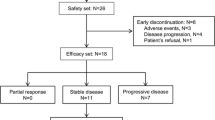Summary
Vascular endothelial growth factor (VEGF) is a potent stimulant of angiogenesis. SU5416, is a small molecule tyrosine kinase inhibitor, and a potent inhibitor of VEGF- mediated Flk-1 receptor signaling. Intravenous agent SU5416 has shown evidence of biological activity against a variety of tumor types. The current intravenous dosing regimen is not optimal for long-term administration, which is needed for optimal efficacy. The aim of this study was to evaluate the safety profile and pharmacokinetics of a Nanocrystal Colloidal DispersionTM (NCD) SU5416 formulation in humans. Patients with advanced and/or metastatic solid organ tumors were included in the trial; various SU5416 regimens were tested for tolerability, safety and were evaluated concerning pharmacokinetics. The results of this study indicate that induction of clearance after oral dosing of NCD SU5416 in humans occurs and is greater than following IV administration. It has been confirmed that SU5416 is a high clearance compound, also as an oral NCD formulation. The NCD formulation was well tolerated, but no effective drug serum levels could be achieved. These data help to understand the ADME (Absorption, Distribution, Metabolism, Excretion) properties of indoline chemical class compounds. The lessons learned should be applied in the development of next generation indoline anti-angiogenic and anti-tumor compounds.
Similar content being viewed by others
References
Folkman J: Antiangiogenic therapy. In: de Vita VT Jr, Hellman S, Rosenberg SA (eds.): Cancer: Principles and practice of oncology, 5th edn. Philadelphia, PA: Lippincott-Raven, 3075–085, 1997
Berlin JD: Targeting vascular endothelial growth factor in colorectal cancer. Oncol Suppl 16(8): 13–5, 2002
Lee JC, Chow NH, Wang ST, et al.: Prognostic value of vascular endothelial growth factor expression in colorectal cancer patients. Eur J Cancer 36: 748–53, 2000
Pinedo HM, Slamon J: Translational Research: The role of VEGF in tumor angiogenesis. Oncologist 5: 1–, 2000
Ferrara N: Role of Vascular Endothelial Growth Factor in physiologic and pathologic angiogenesis: therapeutic implications. Sem Oncol 29(6), (Suppl. 16): 10–4, 2002
Kabbinavar F, Hurwitz H, Fehrenbacher L, Meropol N, Novotny W, Lieberman G, et al.: Phase II, randomized trial comparing bevacizumab plus fluorouracil (FU)(leucovorin (LV) with FU/LV alone in patients with metastatic colorectal cancer. J Clin Oncol 21(1): 60–5, 2003
Fong TA, Shawver LK, Sun L, et al.: SU5416 is a potent and selective inhibitor of the vascular endothelial growth factor receptor (Flk-1/KDR) that inhibits tyrosine kinase catalysis, tumor vascularization, and growth of multiple tumor types. Cancer Res 59: 99–06, 1999
Sukbuntherng J, Cropp G, Hannah A, Wagner G, Shawver L, Antonian L: Pharmacokinetics and Interspecies Scaling of a novel VEGF receptor inhibitor, SU5416. J Pharmacy Pharmacol 53: 1629–636, 2001
Salzberg M, Pless M, Rochlitz C, Scigalla P, Herrmann R: A phase I and pharmacokinetic study of oral administration of SU5416 in patients with advanced solid tumors. Presentation at poster workshop session on Phase I/Clinical Pharmacology ECCO 2003, Copenhagen
Antonian L, Zhang H, Yang C, Wagner G, Shawver L, Shet M, et al.: Biotransformation of the Anti-Angiogenic compound SU5416. Drug Metab Disposit 28: 1505–512, 2000
Ogilvie, Scheinkönig JA, Antonian L, Ye C, Tan W, Madan A, Parkinson A: SU5416 undergoes concerted (two-step) oxidation by human CYP1A2 to an alcohol and then the corresponding carboxylic. Drug Metab Rev 23(S1): 111, 2002
Internal Sugen Data onFile
Raeissi SD, Waltz K, Sukbuntherng J, Lipson K, Sweeney D, Kim TW, Antonian L: In vitro model to elucidate the potential of the receptor of the receptor tyrosine kinase (RTK) inhibitor SU5416 to induce CYP1A1. Proc Am Ass Cancer Res 42: 190, 2001
Solis WA, Wong SGW, Vela J, Antonian, Sweeney DJ: Investigation into the mechanism of CYP1A1 induction by indolinone receptor tyrosine kinase inhibitors. Presented in IUPHAR, San Francisco, CA, 7/2002
Stoppeck A, Sheldon M, Vahedian M, Cropp G, Gosalia R, Hannah A: Results of a phase I dose-escalating study of the antiangiogenic agent, SU5416, in patients with advanced malignancies. Clin Cancer Res 8: 2798–805, 2002
Mendel D, Schreck R, West DC, Li G, Strawn L, Tanciongco S, et al.: The angiogenesis inhibitor SU5416 has long lasting effects on VEGF receptor phosphorylation and function. Clin Cancer Res 6: 4848–858, 2000
Laird A, Vajkoczy P, Shawver L, Thurnher A, Liang C, et al.: SU6668 is a potent anti-angiogenic and anti-tumor agent which induces regression of established tumors. Cancerv Res 60: 4152–160, 2000
Author information
Authors and Affiliations
Rights and permissions
About this article
Cite this article
Salzberg, M., Pless, M., Rochlitz, C. et al. A phase I Study with oral SU5416 in patients with advanced solid tumors: A drug inducing its clearance. Invest New Drugs 24, 299–304 (2006). https://doi.org/10.1007/s10637-005-4061-z
Published:
Issue Date:
DOI: https://doi.org/10.1007/s10637-005-4061-z




